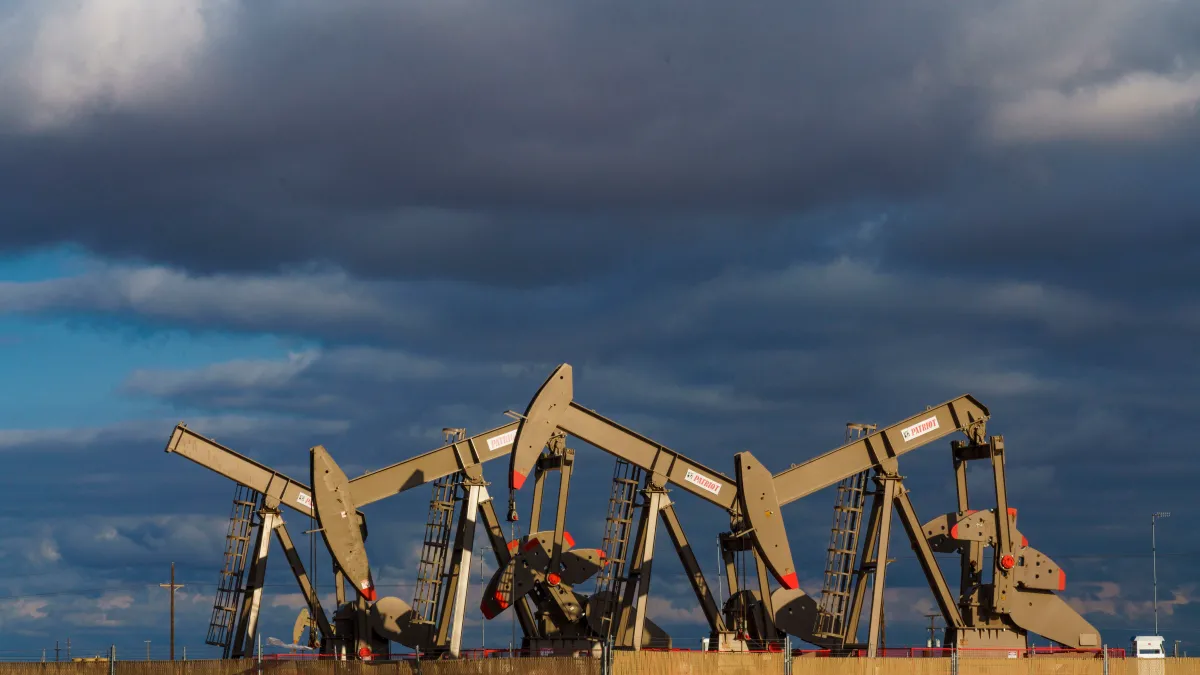Why Is The Free Flow of Oil Important?
Why does the price of oil change so much? Learn how crude oil affects the global economy and the potential for economic development, and how fluctuating prices can contribute to crises.
The disruptions caused by the COVID-19 pandemic were unprecedented on many levels. This includes the collapse of the global oil market. Oil is normally one of the most valuable products in the world. But just months after COVID-19 emerged, the price of Texas oil briefly fell below $0—that is, companies with reserves of oil were willing to pay someone else to take it off their hands.
The upending of the oil market highlighted how vital a world commodity oil remains and how deeply intertwined it is with the global economy.
This resource will examine the international oil market, detailing who the major participants are, how oil pricing works, what price shocks are, and what the future could hold for oil.
What is oil and who produces it?
Crude oil, also known as petroleum, is most commonly found in large underground reservoirs. Crude oil takes millions of years to form and is made up of plants and animals crushed under sediment and heated without oxygen. It’s extracted using large drills and then refined to turn it into the products that people consume. Those products include gasoline and jet fuel, critical energy sources for the world economy, as well as various plastics and petrochemicals used to make clothing, furniture, tires, mobile-phone shells, and many familiar medicines (including an ingredient of the Pfizer and Moderna COVID-19 vaccines).
Roughly one hundred countries produce oil, but just a handful produce most of the world’s supply. In 2021, the top oil-producing countries (in order) were the United States, Saudi Arabia, Russia, Canada, and China.
A major figure in the world oil market is a group of countries called the Organization of the Petroleum Exporting Countries (OPEC). OPEC, established in 1960, now consists of thirteen top oil-producing countries spanning Africa, the Middle East, and South America, which together control nearly 40 percent of global oil supply. In most OPEC countries, the oil is controlled by the government. Though oil companies will often be partners, member countries, working together, can significantly affect the oil market.
However, although OPEC gets many headlines, it is often reacting to market conditions. When prices are low, OPEC countries will try to hold back production, with varying levels of success. When prices are high, they will make more oil available. But often, the forces of supply and demand, which are affected by world economic growth, end up controlling what happens to the price.
What causes oil prices to fluctuate?
Oil is a fungible commodity, and it is a global commodity. That means it can be traded anywhere in the world, moved by pipelines and huge tankers. Oil quality differs from one region to another, and so what is called “light sweet crude’’ will sell for a higher price than “heavy oil.” But all the prices relate back to the global price, with those quality differences defining the price of a specific crude oil. Thus, oil has a global price susceptible to fluctuations in the global market. Think of oil commodity pricing like a swimming pool—taking a bucket of water out in one corner affects the depth across the entire pool. So, when prices decrease in one region of the world, a ripple effect causes decreases elsewhere until the price is more or less even globally. Hence, an upward spike in the price of oil will also be felt around the world.
Oil prices can fluctuate steadily or with rapid and often turbulent increases and decreases. A violent change is known as a price shock. Price shocks can occur when a war, major accident, or other extenuating circumstance, such as COVID-19, interrupts a major source of oil, causing disruptions on either the supply or demand side of the oil market. Because oil is a significant driver of the economy, oil price shocks often have severe and wide-ranging consequences.
What are examples of oil price shocks?
1970s Oil Crisis
In 1973, Arab oil producers halted oil exports to the United States and other countries to protest U.S. support for Israel in the Yom Kippur War. The embargo resulted in fuel shortages, causing oil prices in the United States to soar from $3 a barrel to $12. The embargo was lifted when the United States negotiated a deal between Israel and Egypt.
This crisis led to a shift in U.S. energy policy. The United States was the world’s largest oil producer for the first half of the twentieth century and indeed provided most of the oil used by the Allies during World War II. However, by the beginning of the 1970s, the United States was importing most of its oil. The oil crisis that decade prompted fears in the United States over dependence on foreign oil and made energy independence—not having to rely on foreign countries for oil and other sources of energy—a domestic policy goal.
The Gulf War
In August 1990, Iraq invaded Kuwait, prompting immediate international opposition. After Iraq refused to withdraw from its oil-rich neighbor, the United States mobilized an international coalition to liberate Kuwait, citing Iraq’s gross violation of international law and its threat to the global oil supply on which the world economy depended. Oil prices rose sharply before the war but actually fell at the war’s outset, because the United States and other governments released a large amount of oil from their stockpiles.
An attempt by any outside force to gain control of the Persian Gulf region will be regarded as an assault on the vital interests of the United States of America, and such an assault will be repelled by any means necessary, including military force.
The United States involvement in the Gulf War was then the largest U.S. military deployment since World War II. Kuwait was liberated in February 1991, though most of its oil industry had been damaged and had to be restored.
COVID-19 pandemic
The pandemic was a major shock to the oil industry on the demand side. In 2020, demand plummeted by 30 percent compared to the previous year as travel halted, offices closed, people stayed home, and factories shuttered due to COVID-19 lockdowns. This caused oil prices to fall dramatically as a huge surplus of unsold oil accumulated. Preventing the oil industry from a collapse required unprecedented cooperation between the big three producers—the United States, Russia, and Saudi Arabia—and many others. Supply cuts reduced the huge surplus and calmed the market.
Will sustainable energy sources replace oil?
Oil is a key driver of the global economy. But its extraction and use are also accelerating climate change. This fact, plus the volatility in oil supply and demand, has facilitated a push for new, more sustainable energy sources. Many alternative energy sources, such as wind and solar power, are getting cheaper, and government subsidies and regulations are incentivizing investment in sustainable energy.
China, which is the world’s greatest emitter of greenhouse gases, has made a significant commitment to sustainable energy sources. In 2021, they invested over $200 million in transitioning to sustainable energy, more than twice what the United States spent in the same year. In the United States, electric utilities are mostly committing to wind and solar for their new generating plants. American automakers have pledged to shift to selling mostly or only electric vehicles. Becoming completely electric will take time for the U.S. auto fleet because the average car stays on the road for about a dozen years.
However, although the world is shifting toward renewables, oil remains the core of the global economy and will maintain significance for years to come.




